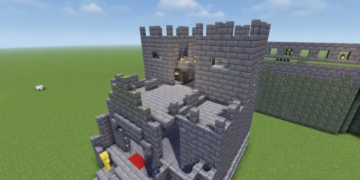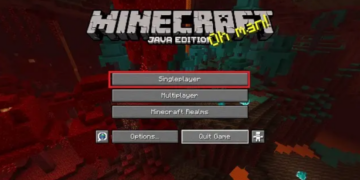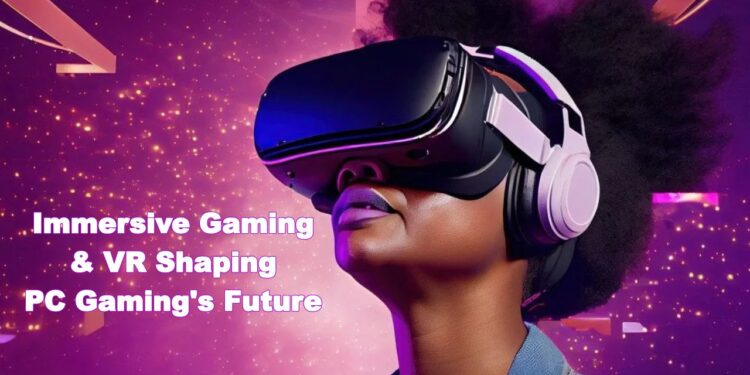The gaming world is changing faster than ever, with new technologies pushing limits and redefining experiences. At the forefront of this transformation is immersive gaming, powered by the integration of Virtual Reality (VR) with PC game development. This dynamic combination creates breathtaking experiences that are interactive, engaging, and incredibly lifelike.
In this post, we’ll dive deep into how immersive gaming is evolving through VR, explore the challenges and opportunities it presents, and take a glimpse into the exciting future of this groundbreaking intersection.
The Rise of Immersive Gaming through VR

Immersive gaming isn’t just a buzzword; it’s a revolution. VR technology has grown from niche beginnings to a key player in the entertainment industry. Unlike traditional gaming setups that rely on screens and controllers, VR introduces a three-dimensional, interactive space where players feel like they’re part of the game.
For PC game developers, VR represents a massive shift. High-end PCs provide the hardware strength to run sophisticated VR games, boasting features like detailed graphics, lightning-fast processors, and ample storage. This powerful combination enables the creation of intricate virtual worlds and pushes the boundaries of immersive gaming.
How VR Enhances Immersive Gaming

Immersive gaming has transformed the way we play, making games more engaging and lifelike. At the heart of this transformation is virtual reality (VR). This powerful technology turns ordinary gaming into a full-body experience, where players interact directly with the game world.
Developers use VR to reimagine how games look, feel, and play. This isn’t just about adding a VR mode; it’s about creating something entirely new. VR amplifies immersive gaming by providing dynamic environments, natural controls, and realistic interactions. Let’s explore how VR enhances the gaming experience and why it’s such a game-changer for PC gamers and developers alike.
Immersive Environments
VR creates environments that feel like stepping into another world. Imagine walking through a magical forest or exploring a futuristic city. These spaces are not just visually stunning—they are interactive. Players can touch, move, and explore, making the game world come alive.
This level of immersion is unmatched in traditional gaming. The realistic details in VR environments keep players engaged, making every moment memorable. Whether it’s solving puzzles or fighting enemies, the connection to the game feels deeply personal.
Natural Controls
VR introduces controls that mimic real-world actions. Instead of pushing buttons, players swing swords, pick up objects, or aim with their hands. These intuitive movements make gaming more exciting and realistic.
For example, in a sports game, you can throw a ball as if you’re on the field. This type of control brings players closer to the action and makes immersive gaming even more engaging. With VR, every movement feels natural, bridging the gap between reality and the virtual world.
Enhanced Realism
VR adds a new layer of realism to immersive gaming. Players can move freely, look around, and interact physically with their surroundings. This makes horror games more frightening, action games more intense, and simulations feel like real-life experiences.
The sense of presence is so strong that players often forget they’re in a game. This heightened realism keeps players coming back for more. It’s no surprise that VR is redefining how we think about games.
Social Connections
Multiplayer VR games take social interaction to another level. Players can meet in shared virtual spaces, talk, and work together. Instead of typing or using a headset, players can gesture and move naturally, just like in real life. This makes teamwork and competition more personal and fun.
Whether you’re playing with friends or meeting new people, VR strengthens connections in ways traditional gaming can’t. Immersive gaming is not just about the game—it’s about the people you share it with.
Challenges in Bringing VR to Immersive Gaming

While VR has revolutionized immersive gaming, it is not without its challenges. Developers must navigate several hurdles to create smooth and enjoyable experiences for players. The most pressing issues include performance optimization, user comfort, development costs, and hardware compatibility.
Each of these challenges can affect how well the game plays and how players experience the virtual world. To make immersive gaming truly seamless, developers must carefully balance these factors. Let’s explore these challenges and understand how they impact the future of VR gaming.
Performance Optimization
One of the biggest challenges in VR is ensuring smooth performance. High-quality immersive gaming experiences require fast frame rates and smooth graphics. If the game lags or stutters, players can experience motion sickness, breaking the immersion.
Developers need to optimize VR games for high-end PCs, ensuring that the gameplay runs smoothly without interruptions. This involves careful coding and testing to make sure the game performs well on different devices. By addressing performance issues, developers can offer a more comfortable and enjoyable experience for players.
User Comfort
Another challenge is ensuring user comfort during VR sessions. Some players experience discomfort when using VR, such as motion sickness or eye strain. To solve this, developers are introducing features like teleportation for smoother movement and adjustable comfort settings. These adjustments help make the virtual world feel more natural.
By allowing players to customize their experience, VR games become more accessible and enjoyable for a wider audience. Enhancing user comfort is key to improving the overall immersive gaming experience.
Development Costs
Creating VR games can be expensive. The tools, skills, and time needed to develop high-quality VR content increase production costs. Unlike traditional games, VR games require special equipment and more detailed design work.
Developers must invest in advanced technology and hire skilled experts to create the best experience. While the potential for success is high, the financial risks can be significant. Game developers must weigh these costs against the potential rewards, deciding whether VR is worth the investment for their project.
Hardware Compatibility
With so many different VR headsets and controllers on the market, ensuring hardware compatibility is a major challenge for developers. Each device has its specifications and features, making it difficult to create a seamless experience across all platforms. Developers must test their games on multiple devices to ensure a consistent and smooth gaming experience.
This process can be time-consuming and complex. Ensuring compatibility is crucial for making VR gaming more accessible and enjoyable for everyone, regardless of the headset they own.
The Role of PCs in Immersive Gaming
PCs are vital to the growth of immersive gaming. Unlike consoles, PCs offer the customization and power required to run complex VR environments. Here’s how PCs support the evolution of VR gaming:
- High-End Graphics: PC hardware can render highly detailed virtual worlds with lifelike textures and effects.
- Flexibility for Developers: PC platforms allow developers to experiment with new ideas and push creative boundaries.
- Wide Accessibility: A large player base ensures VR gaming on PCs remains an exciting and growing market.
The Future of Immersive Gaming

The future of immersive gaming is filled with exciting possibilities. With technology advancing at a rapid pace, we can expect even more realistic, engaging, and interactive gaming experiences. Virtual reality (VR) is evolving quickly, and soon it will transform how we play, learn, and even work.
The potential for immersive gaming stretches far beyond what we know today, with new hardware, applications, and experiences on the horizon.
As technology improves, the virtual worlds we explore will become more lifelike, allowing for deeper immersion and richer experiences. Here’s a look at the future of immersive gaming and what gamers can expect.
Advanced Hardware
The future of immersive gaming depends heavily on the advancement of hardware. Next-generation VR headsets will be lighter and more comfortable. They will feature sharper visuals, offering clearer and more detailed environments. Enhanced tracking systems will make player movements feel more natural and realistic, improving immersion.
With better graphics and performance, players will feel as though they are truly part of the game world. This will elevate the experience, making it more engaging and enjoyable. The development of these hardware advancements will be a game-changer for immersive gaming.
Broader Applications
Immersive gaming is not just for entertainment anymore. As VR technology continues to grow, it is finding new applications in various industries. Virtual reality is already being used in education to create interactive learning experiences. It’s also being applied in healthcare for medical training and therapy.
Additionally, VR is revolutionizing tourism, allowing people to virtually visit places around the world. This opens up new opportunities for developers to create VR experiences that go beyond gaming, turning immersive gaming into a tool for learning, healing, and exploration.
Better Interactivity
The future of immersive gaming will see major advancements in player interactivity. New technologies, such as haptic gloves, will allow players to feel the virtual world through touch. Eye-tracking will help games respond to where players are looking, making actions feel more intuitive.
These technologies will take immersion to new heights, making the game world feel even more real. Players will have more control and deeper interaction, making the gaming experience more dynamic and engaging than ever before. The future promises more ways to experience virtual worlds.
Wider Adoption
As VR technology becomes more affordable, immersive gaming will become more accessible. More gamers will be able to experience VR, fueling demand for high-quality VR games. As more people embrace this technology, developers will be encouraged to innovate further, leading to even better gaming experiences.
This wider adoption will expand the immersive gaming industry and make it a mainstream entertainment option. With increasing accessibility and affordability, immersive gaming will become a central part of many people’s lives, revolutionizing the way we play and interact with digital worlds.
Why Immersive Gaming Matters
Immersive gaming is about creating experiences that go beyond the screen. It places players at the heart of the action, making every decision, move, and interaction feel personal. For developers, this shift offers endless creative opportunities, allowing them to craft stories and worlds that captivate players like never before.
The Road Ahead
The integration of VR into PC gaming is not just a trend—it’s a game-changer. As technology evolves, so do the opportunities for immersive gaming. Developers who embrace Virtual Reality (VR) today are paving the way for tomorrow’s groundbreaking experiences.
Conclusion: Embrace the Future of Immersive Gaming
Immersive gaming powered by VR is revolutionizing the PC game development landscape. By leveraging VR’s potential, developers are delivering games that captivate, inspire, and engage players on a whole new level. As technology advances, the possibilities for creating unforgettable gaming experiences will only grow.
Now’s the time to dive into this exciting world. If you’re a gamer, explore the latest VR titles and discover the magic of immersive gaming. If you’re a developer, embrace the challenges and opportunities VR offers. Together, we can shape the future of gaming.
Ready to explore immersive gaming? Let’s redefine the way you play. Share your thoughts, experiences, or favorite VR games in the comments below!















































